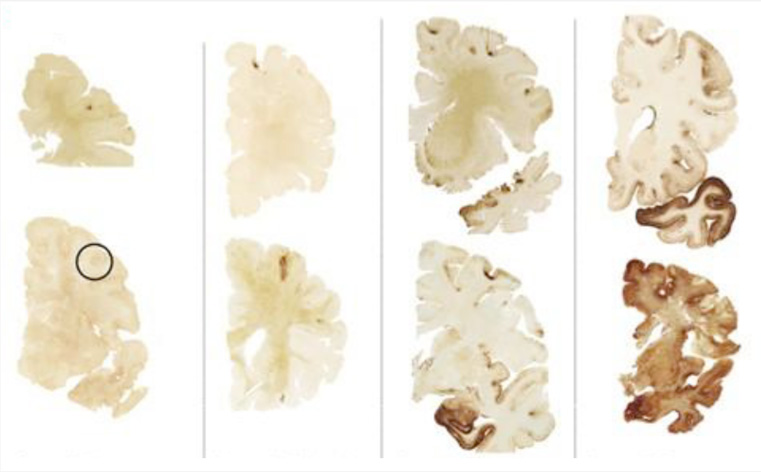WHAT CAUSES CTE?
Head impacts or concussion
The best available evidence tells us that CTE is caused by repetitive hits to the head sustained over a period of years. This doesn’t mean a handful of concussions: most people diagnosed with CTE suffered hundreds or thousands of head impacts over the course of many years playing contact sports or serving in the military.
CTE is not only caused by concussion
The best available evidence points towards sub-concussive impacts, or hits to the head that don’t cause full-blown concussions, as the biggest factor.
WHO IS MOST AT RISK FOR CTE?
Every person diagnosed with CTE has one thing in common: a history of repetitive hits to the head.
CTE is most often found in contact sport athletes and military veterans. This is likely because these are some of the only roles in modern life that involve purposeful, repetitive hits to the head.
CTE has been found in individuals whose primary exposure to head impacts was through:
- Tackle football (200+ cases confirmed at the VA-BU-CLF Brain Bank)
- Military (25+ cases)
- Hockey (20+ cases)
- Boxing (15+ cases, 50+ globally)
- Rugby (5+ cases), soccer (5+ cases, 10+ globally)
- Pro wrestling (5+ cases), and
- In fewer than three cases each, baseball, basketball, intimate partner violence, and individuals with developmental disorders who engaged in head banging behaviors.
Importantly, not everyone who has suffered repetitive hits to the head will develop CTE. There are several risk factors at play that make some people more prone to develop CTE than others, including:
Age of first exposure to head impacts
Athletes who begin playing contact sports at younger ages are at greater risk for CTE. Several published studies show that exposure to head impacts before age 12 is associated with worse outcomes than starting after age 12.
Length of exposure to head impacts
Athletes with longer careers playing contact sports are at greater risk than athletes with shorter careers. Among those diagnosed with CTE, athletes with longer careers are more likely to have more severe pathology than those with shorter careers.
There are very likely other risk factors that have yet to be discovered, including possible genetic differences that make some people more prone to develop CTE than others. More research will help scientists determine what those factors might be, and could help us understand how to prevent and treat the disease.
| CTE has been found in… |
Source of head impacts |
| Boxers |
Punches to the head |
| Tackle football players |
Hits to the helmet |
| Soccer players |
Headers and collisions |
| Ice hockey players |
Fighting, checking |
| Military veterans |
Blast injuries, combat |
| Victims of domestic abuse |
Repeated violence |
HOW IS CTE DIAGNOSED?
Currently, CTE can only be diagnosed after death through brain tissue analysis. Doctors with a specialty in brain diseases slice brain tissue and use special chemicals to make the Tau clumps visible. They then systematically search areas of the brain for Tau clumps with a unique pattern specific to CTE.
The brain tissue analysi process can take several months to complete, and the analysis is not typically performed as a part of a normal autopsy. In fact, until recently there were relatively few doctors who knew how to diagnose CTE.
In 2015, researchers from the VA-BU-CLF Brain Bank, led by Dr. Ann McKee, collaborated with the National Institutes of Health to develop diagnostic criteria for CTE, so that any neuropathologist familiar with brain diseases can accurately diagnose CTE. This important work has made it possible for more and more scientists to be on the lookout for CTE, helping accelerate progress.
I SUFFERED A CONCUSSION. IS THAT GOING TO GIVE ME CTE?
One concussion in the absence of other brain trauma has never been seen to cause CTE.
The best evidence available today suggests that CTE is not caused by any single injury, but rather it is caused by years of regular, repetitive brain trauma. These might be obvious, graphic episodes of concussion (a player knocked-out or staggring after an impact) or the result of many smaller “sub-concussive” impacts. There are also many individuals who suffer years of head impacts, but do not develop CTE. More research will help us understand these factors in the future.
Learn More about what is a subconcussive impact?
 Hear Dr. Robert Stern, Director of Clinical Research at the Boston University CTE Center, explain why CTE is not a death sentence, how those who are suffering can have hope that their symptoms can be treated, and why loved ones are so important in instilling that hope.
Hear Dr. Robert Stern, Director of Clinical Research at the Boston University CTE Center, explain why CTE is not a death sentence, how those who are suffering can have hope that their symptoms can be treated, and why loved ones are so important in instilling that hope. 



